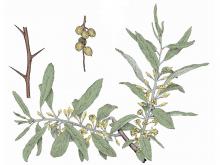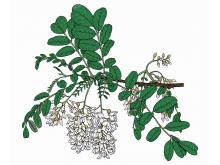Trees, Shrubs and Woody Vines
Media

Species Types
Scientific Name
Elaeagnus angustifolia
Description
Russian olive is a small tree with distinctive silvery leaves. It was introduced to America in the late 1800s and widely planted as an ornamental and windbreak. But in many states it has proven to be invasive. It is not recommended here in Missouri.
Media

Species Types
Scientific Name
Robinia pseudoacacia
Description
Black locust, a member of the bean family, is easy to appreciate in May and June, when its showy white clusters of flowers perfume the breeze with their sweet smell. Bees like the flowers, too.
Media

Species Types
Scientific Name
Rosa multiflora
Description
Starting more than a century ago, this nonnative rose was planted across America — for many good reasons — but multiflora rose has proven to be invasive, and now the goal is to stop its spread.
Media

Species Types
Scientific Name
Rubus allegheniensis
Description
Common blackberry is only one of several species of blackberry in our state. It grows in rocky, open woods, along bluffs and fencerows, on glades, and in thickets, old fields, and open valleys nearly statewide.
Media

Species Types
Scientific Name
Zanthoxylum americanum
Description
Common prickly ash is a thicket-forming shrub or small tree. Its compound leaves resemble of those of ash trees, but it’s in a different family. Pairs of stout, curved prickles occur at each node. Scattered statewide, but less common in the Ozarks.
See Also
About Trees, Shrubs and Woody Vines in Missouri
There are no sharp dividing lines between trees, shrubs, and woody vines, or even between woody and nonwoody plants. “Wood” is a type of tissue made of cellulose and lignin that many plants develop as they mature — whether they are “woody” or not. Trees are woody plants over 13 feet tall with a single trunk. Shrubs are less than 13 feet tall, with multiple stems. Vines require support or else sprawl over the ground.





















